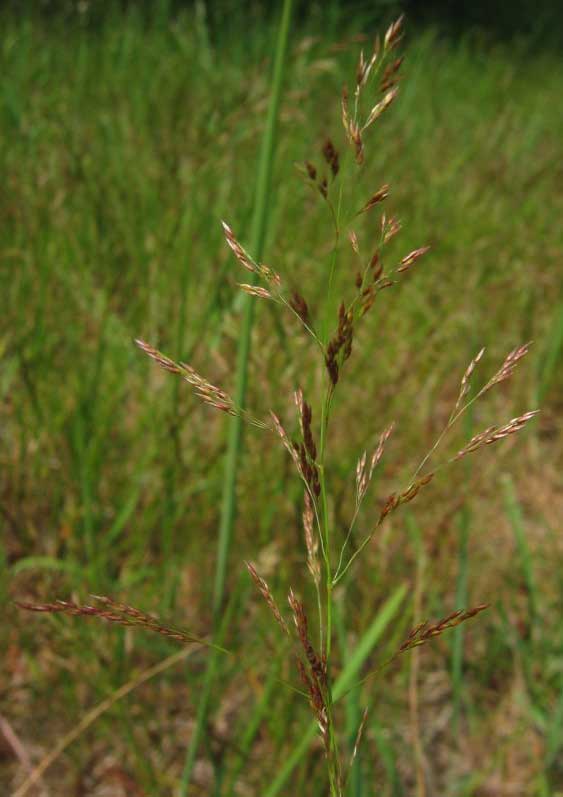
Agrostis capillaris ( *)
Classification System: APG IV
Superregnum: Eukaryota
Regnum: Plantae
Cladus: Angiosperms
Cladus: Monocots
Cladus: Commelinids
Ordo: Poales
Familia: Poaceae
Subfamilia: Pooideae
Tribus: Aveneae
Subtribus: Agrostidinae
Genus: Agrostis
Species: Agrostis capillaris
Name
Agrostis capillaris L. Sp. Pl. 1: 62 (1753)
Synonyms
Agrostis tenuis Sibth. Fl. oxon. 36. 1794
References
Primary references
Linnaeus, C. 1753. Species Plantarum. Tomus I: 62. Reference page.
Sibthorp, J. 1794. Flora Oxoniensis, exhibens plantas in agro Oxoniensi sponte crescentes, secundum systema sexuale distributas. Oxford. BHL Reference page. [See page 36–37.]
Links
Agrostis capillaris – Taxon details on Integrated Taxonomic Information System (ITIS).
Agrostis tenuis – Taxon details on Integrated Taxonomic Information System (ITIS).
USDA, NRCS. 2006. The PLANTS Database, 6 March 2006 (http://plants.usda.gov). Data compiled from various sources by Mark W. Skinner. National Plant Data Center, Baton Rouge, LA 70874-4490 USA.
USDA, ARS, Germplasm Resources Information Network. Agrostis capillaris in the Germplasm Resources Information Network (GRIN), U.S. Department of Agriculture Agricultural Research Service.
Vernacular names
Deutsch: Rotes Straußgras
English: Common bent
eesti: Harilik kastehein
suomi: Nurmirölli
français: Agrostis commun
polski: Mietlica pospolita
русский: Полевица тонкая
svenska: Rödven
Agrostis capillaris, the common bent, colonial bent, or browntop, is a rhizomatous and stoloniferous perennial in the grass family (Poaceae). It is native to Eurasia and has been widely introduced in many parts of the world.[3] Colonial bent grows in moist grasslands and open meadows, and can also be found in agricultural areas, roadsides, and invading disturbed areas.[4]
The name Agrostis comes from the Greek word meaning forage plant, agros meaning "a field".
It is found growing in neutral to acidic soils. It has a very fine texture and like most bent grasses grows very dense. Although this species is used on golf courses, providing some of the best ball playing surfaces in the world, it also produces a spectacular visual appearance when maintained properly. It provides an excellent home lawn but is not tolerant of heavy use. Colonial bent is fairly easy to grow from seeds and fertilization of the lawn is not as intense. This grass also takes longer to establish than creeping bent. However, it does not require the intense maintenance.[5]
Many internet sources describe it as being the tallest of the bent species. However, C. E. Hubbard describes its height as ranging from 10 to 70 cm high, whereas the black bent Agrostis gigantea is 40 to 120 cm. Marjorie Blamey, Richard and Alastair Fitter also describe black bent as being taller.[6][7]
Description
It forms a dense sward of fine leaves. The ligule is short and does not come to a point. This differs from creeping bent, Agrostis stolonifera in which it is pointed and up to 5mm long.
The flowering panicles appear from May until June. They are finely branched and look like a purple haze from a distance. The panicle persists in winter after the seeds have been shed.[8]
Environmental conservation
Agrostis capillaris forms a constituent of purple moor grass and rush pastures, a type of Biodiversity Action Plan habitat in the UK. This habitat occurs on poorly drained neutral and acidic soils of the lowlands and upland fringe, and can be found in the south-west of England, especially in Devon. It is found on upland pastures throughout the UK.
References
Plants Profile for Agrostis Capillaris Retrieved 14 March 2010.
"Agrostis capillaris". Germplasm Resources Information Network (GRIN). Agricultural Research Service (ARS), United States Department of Agriculture (USDA). Retrieved 15 March 2010.
"Grass Manual on the Web". Archived from the original on 11 June 2011. Retrieved 15 March 2010.
"Global Invasive Species Database: Ecology of Agrostis capillaris". Invasive Species Specialist Group. Retrieved 15 March 2010.
Watson, L.; Dallwitz, M. J. (2008). "The grass genera of the world: descriptions, illustrations, identification, and information retrieval; including synonyms, morphology, anatomy, physiology, phytochemistry, cytology, classification, pathogens, world and local distribution, and references". The Grass Genera of the World. Archived from the original on 24 July 2008. Retrieved 19 August 2009.
Hubbard, C. E. (1978). Grasses. Penguin.
Blamey, Marjorie; Fitter, Richard and Alistair (2003). Wild Flowers of Britain and Ireland. ISBN 0-7136-5944-0.
"BSBI Description". Archived from the original on 17 July 2011. Retrieved 16 November 2010.
Retrieved from "http://en.wikipedia.org/"
All text is available under the terms of the GNU Free Documentation License

